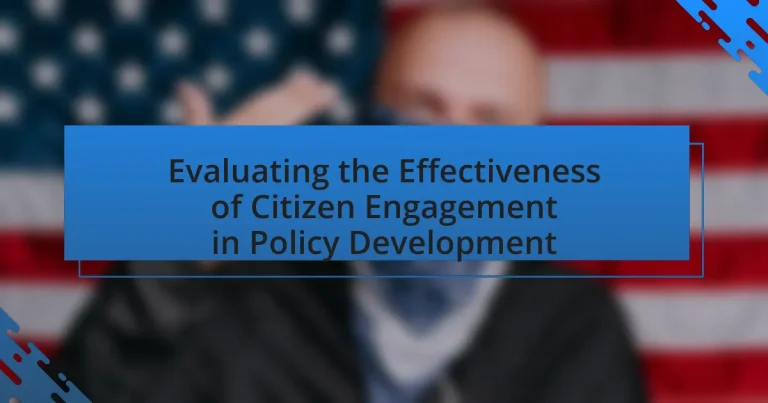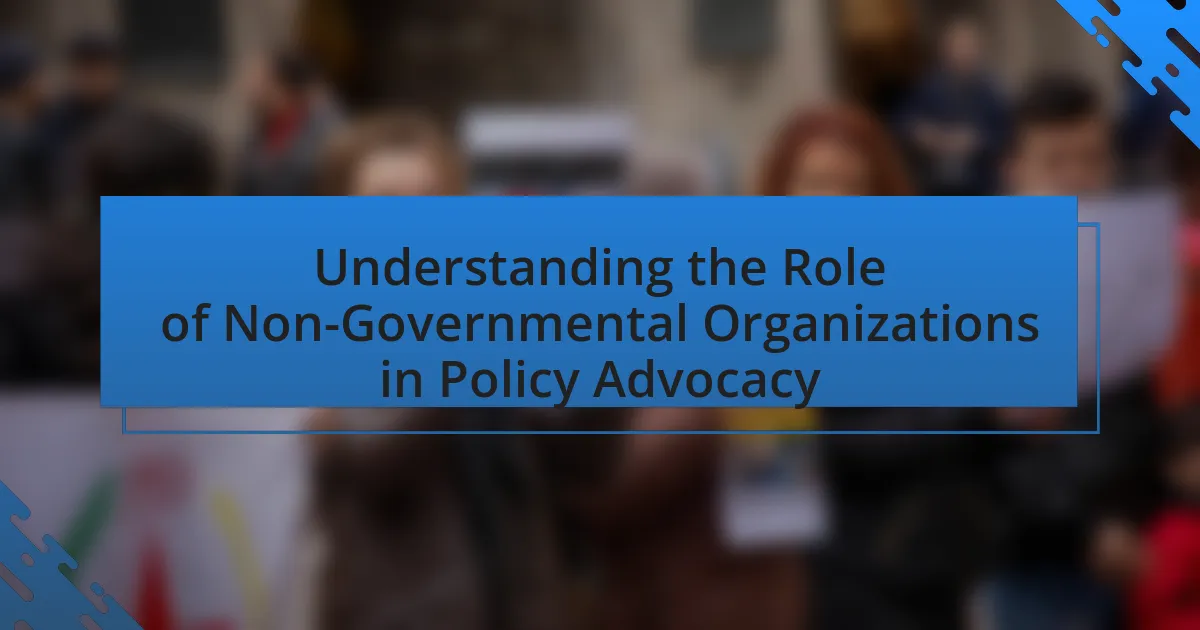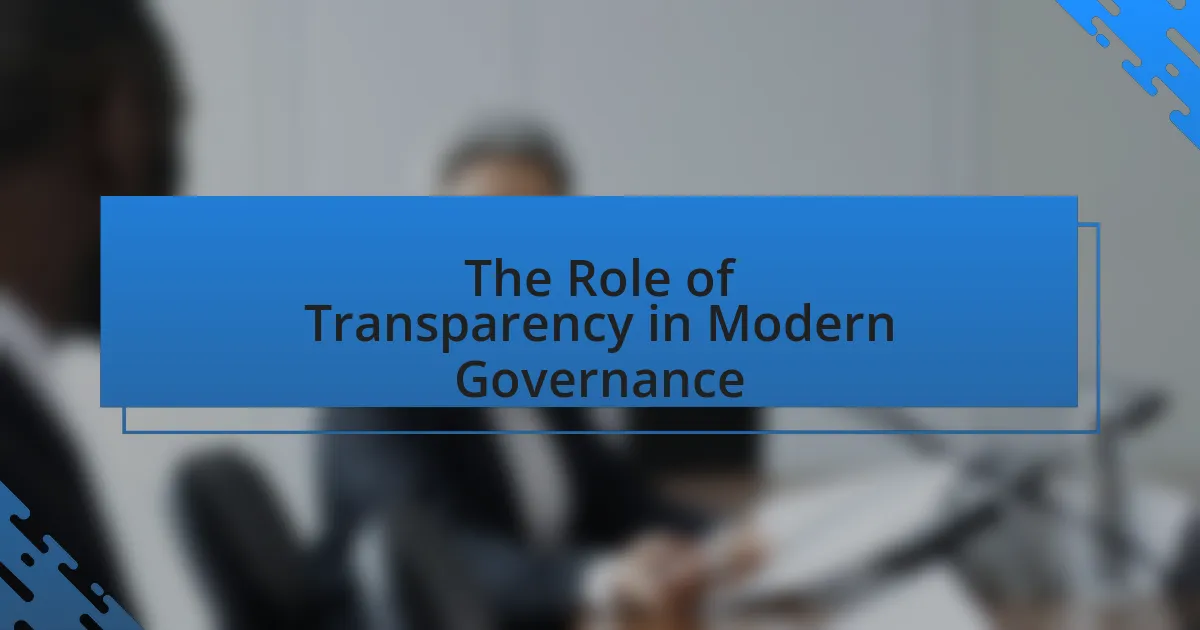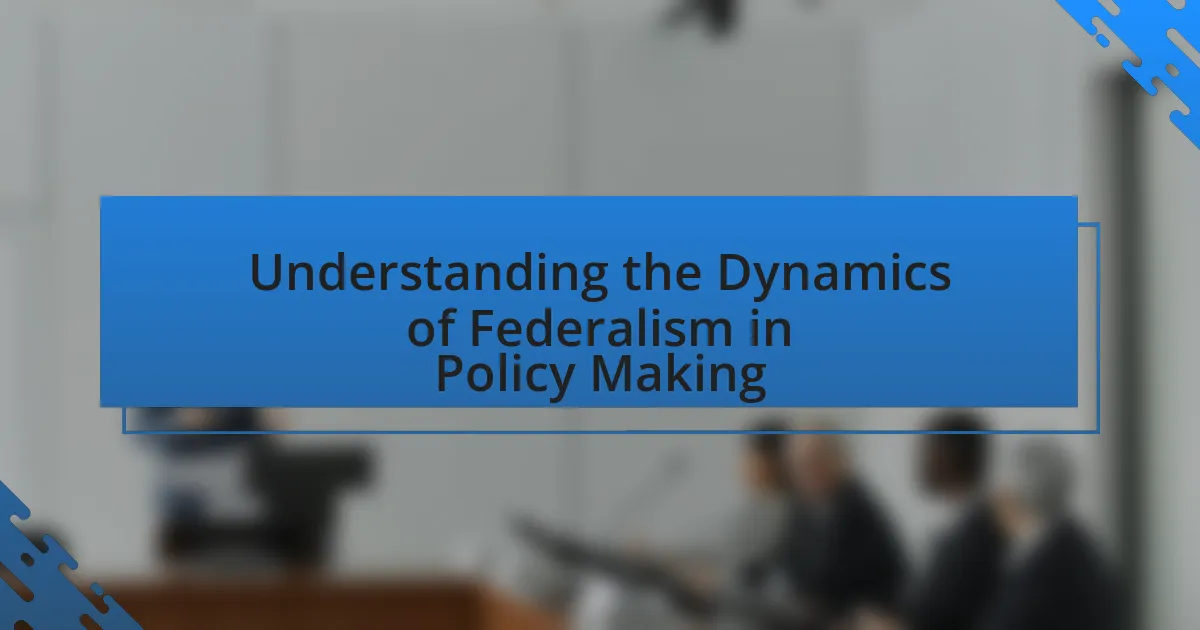The article focuses on evaluating the effectiveness of citizen engagement in policy development, emphasizing its critical role in ensuring community voices are integrated into decision-making processes. It outlines how citizen participation enhances policy legitimacy and effectiveness, leading to better outcomes and increased public trust. The article discusses various mechanisms for facilitating engagement, the impact of different engagement forms on policy effectiveness, and the importance of evaluating citizen engagement through specific metrics. Additionally, it addresses challenges in evaluation, including biases and resource limitations, while offering best practices and strategies to improve engagement evaluations.
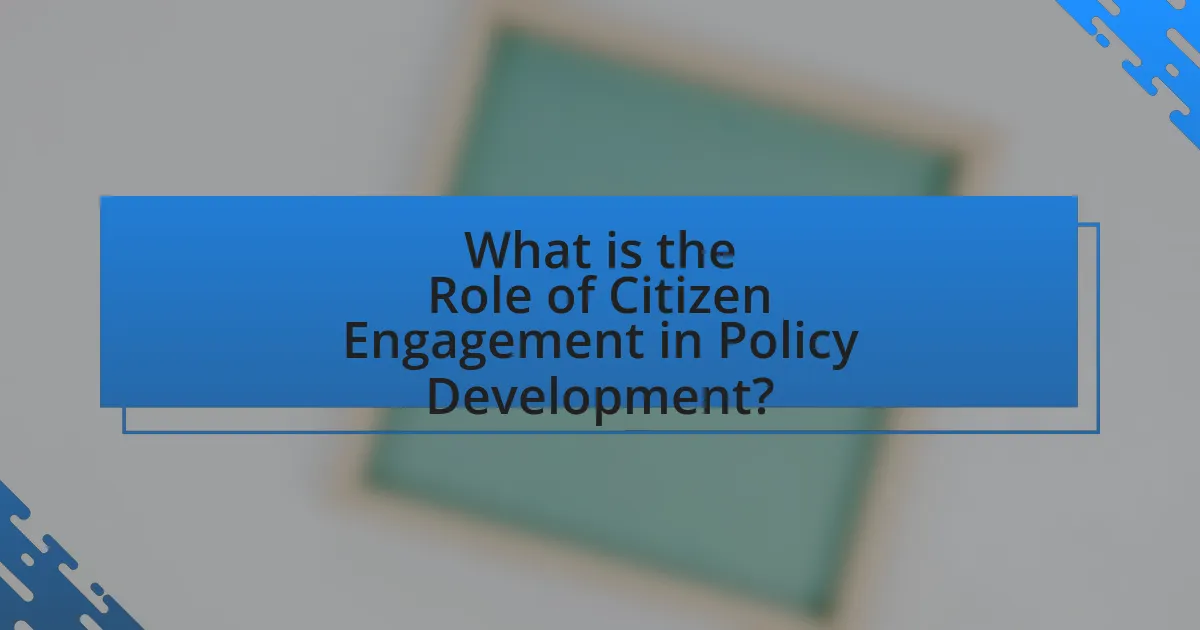
What is the Role of Citizen Engagement in Policy Development?
Citizen engagement plays a crucial role in policy development by ensuring that the voices of the community are heard and considered in decision-making processes. This involvement enhances the legitimacy and effectiveness of policies, as it allows policymakers to understand the needs and preferences of the population they serve. Research indicates that when citizens participate in policy formulation, it leads to more informed and relevant outcomes, as evidenced by studies showing that inclusive processes can improve public trust and compliance with regulations. For instance, a report by the OECD highlights that citizen engagement can lead to better policy outcomes by fostering collaboration between government and the public, ultimately resulting in policies that are more reflective of societal needs.
How does citizen engagement influence policy outcomes?
Citizen engagement significantly influences policy outcomes by ensuring that the voices and needs of the community are reflected in decision-making processes. When citizens actively participate, they provide valuable insights and feedback that can lead to more effective and relevant policies. For instance, research conducted by the National Civic League shows that communities with higher levels of citizen engagement tend to have policies that better address local issues, resulting in improved public satisfaction and trust in government. This correlation highlights the importance of involving citizens in policy development to create solutions that are not only effective but also widely supported by the community.
What mechanisms facilitate citizen participation in policy-making?
Mechanisms that facilitate citizen participation in policy-making include public consultations, participatory budgeting, citizen advisory boards, and online platforms for feedback. Public consultations allow citizens to voice their opinions during the policy development process, ensuring that diverse perspectives are considered. Participatory budgeting empowers citizens to directly influence budget allocations, fostering a sense of ownership and accountability. Citizen advisory boards provide structured opportunities for community members to advise policymakers, enhancing transparency and trust. Online platforms, such as surveys and forums, enable broader engagement by allowing citizens to provide input conveniently, thus increasing participation rates. These mechanisms have been shown to improve policy outcomes by aligning them more closely with community needs and preferences.
How do different forms of engagement impact policy effectiveness?
Different forms of engagement significantly impact policy effectiveness by influencing the quality of decision-making and fostering public trust. For instance, participatory engagement methods, such as public consultations and collaborative workshops, have been shown to enhance policy outcomes by incorporating diverse perspectives, which leads to more comprehensive and relevant solutions. Research conducted by the International Association for Public Participation indicates that policies developed through stakeholder engagement are 30% more likely to be successfully implemented, as they reflect the needs and preferences of the community. Additionally, transparent engagement processes build trust between policymakers and citizens, resulting in higher compliance and support for policies. Thus, the nature and quality of engagement directly correlate with the effectiveness of policy implementation and public acceptance.
Why is evaluating citizen engagement important?
Evaluating citizen engagement is important because it measures the effectiveness of public participation in policy development. This evaluation helps identify how well citizens’ voices are heard and integrated into decision-making processes, which can lead to more informed and representative policies. Research indicates that effective citizen engagement can enhance trust in government, improve policy outcomes, and foster a sense of community ownership over local issues. For instance, a study by the National Civic League found that communities with higher levels of citizen engagement reported greater satisfaction with local governance and better public services.
What metrics are used to assess the effectiveness of citizen engagement?
Metrics used to assess the effectiveness of citizen engagement include participation rates, feedback quality, and outcome impact. Participation rates measure the number of citizens involved in engagement activities, indicating the level of interest and outreach effectiveness. Feedback quality evaluates the relevance and depth of citizen input, often assessed through surveys or focus groups, which helps gauge the engagement’s meaningfulness. Outcome impact examines the tangible changes resulting from citizen input, such as policy adjustments or community initiatives, providing evidence of the engagement’s influence on decision-making processes. These metrics collectively offer a comprehensive view of how effectively citizens are engaged in policy development.
How can evaluation improve future policy development processes?
Evaluation can improve future policy development processes by providing data-driven insights that inform decision-making. By systematically assessing past policies, stakeholders can identify successful strategies and areas needing improvement, which enhances the overall effectiveness of future initiatives. For instance, a study by the OECD found that countries that regularly evaluate their policies are more likely to achieve better outcomes and foster public trust. This evidence demonstrates that evaluation not only highlights best practices but also helps in refining engagement methods, ensuring that citizen input is effectively integrated into policy formulation.
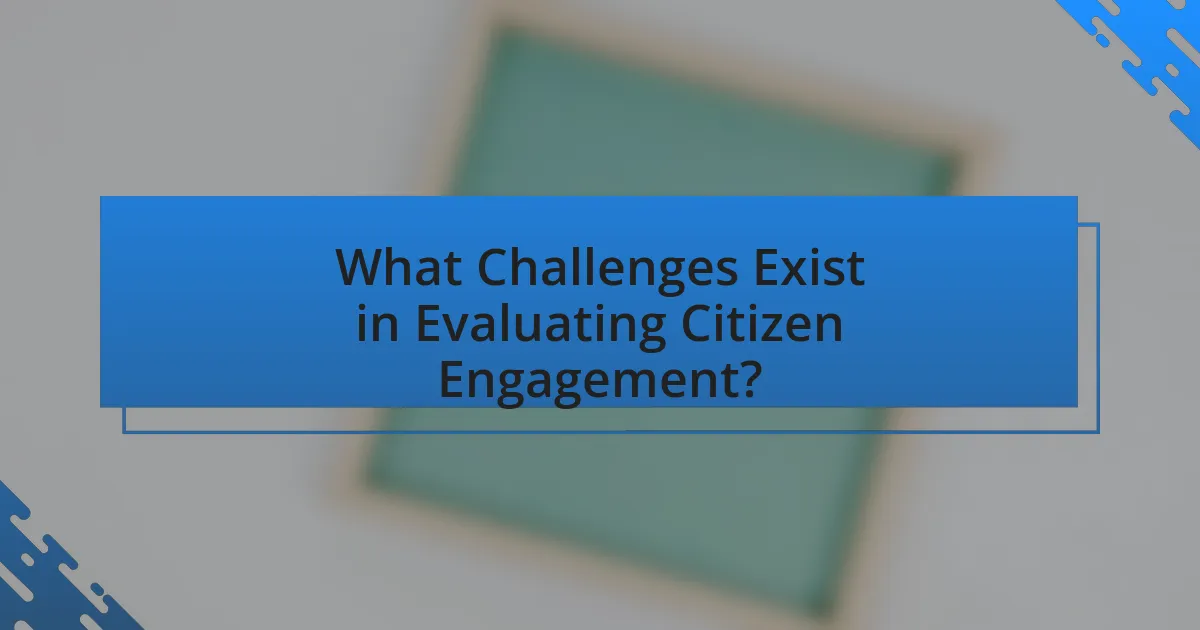
What Challenges Exist in Evaluating Citizen Engagement?
Evaluating citizen engagement presents several challenges, primarily due to the complexity of measuring qualitative outcomes and the diversity of engagement methods. Traditional metrics often focus on quantitative data, such as participation rates, which do not capture the depth of citizen input or the quality of interactions. Additionally, varying definitions of engagement across different communities can lead to inconsistent evaluations. For instance, a study by the National Civic League highlights that engagement can range from simple attendance at meetings to active participation in decision-making processes, complicating standardization. Furthermore, biases in who participates can skew results, as marginalized groups may be underrepresented, leading to incomplete assessments of engagement effectiveness. These factors collectively hinder a comprehensive evaluation of citizen engagement in policy development.
What are common barriers to effective citizen engagement evaluation?
Common barriers to effective citizen engagement evaluation include lack of clear objectives, insufficient resources, and inadequate data collection methods. Clear objectives are essential for guiding the evaluation process; without them, it becomes challenging to measure success or impact. Insufficient resources, such as funding and personnel, hinder the ability to conduct thorough evaluations, limiting the scope and depth of analysis. Additionally, inadequate data collection methods can lead to unreliable or incomplete information, making it difficult to assess the effectiveness of engagement efforts. These barriers collectively impede the ability to accurately evaluate citizen engagement in policy development.
How do resource limitations affect evaluation efforts?
Resource limitations significantly hinder evaluation efforts by restricting the availability of necessary tools, personnel, and funding. When organizations face budget constraints, they often lack the capacity to conduct comprehensive assessments, leading to incomplete data collection and analysis. For instance, a study by the American Evaluation Association found that 60% of evaluators reported that insufficient resources limited their ability to implement rigorous evaluation methodologies. This lack of resources can result in biased findings, as evaluations may rely on less reliable data sources or simplified metrics, ultimately undermining the credibility and effectiveness of citizen engagement assessments in policy development.
What role does public perception play in the evaluation process?
Public perception significantly influences the evaluation process by shaping the criteria and standards used to assess citizen engagement in policy development. When the public views engagement efforts positively, it often leads to higher participation rates and more constructive feedback, which are critical for effective evaluation. Conversely, negative public perception can result in skepticism towards the evaluation outcomes, undermining the credibility of the process. Research indicates that public trust and satisfaction directly correlate with the perceived effectiveness of engagement initiatives, highlighting the importance of addressing public concerns and expectations to ensure a comprehensive evaluation.
How can biases impact the evaluation of citizen engagement?
Biases can significantly distort the evaluation of citizen engagement by skewing perceptions and interpretations of participation data. For instance, confirmation bias may lead evaluators to favor information that supports their pre-existing beliefs about citizen involvement, while neglecting contradictory evidence. Additionally, social desirability bias can cause citizens to provide responses they believe are more acceptable, rather than their true opinions, thus misrepresenting the level of genuine engagement. Research indicates that these biases can result in misleading conclusions about the effectiveness of engagement strategies, ultimately affecting policy development outcomes. For example, a study by the National Civic League found that biased evaluations often overlook marginalized voices, leading to policies that do not reflect the needs of the entire community.
What strategies can mitigate bias in evaluation results?
To mitigate bias in evaluation results, employing diverse evaluation teams is essential. Diverse teams bring varied perspectives, which can help identify and counteract potential biases in the evaluation process. Research indicates that diverse groups are more effective at problem-solving and decision-making, as they challenge each other’s assumptions and reduce groupthink. Additionally, implementing standardized evaluation criteria ensures consistency and fairness in assessments, minimizing subjective interpretations that can lead to bias. A study by the National Academy of Sciences highlights that standardized metrics improve the reliability of evaluation outcomes by providing clear benchmarks for comparison. Furthermore, incorporating anonymous feedback mechanisms can reduce social desirability bias, allowing participants to express their views more freely. These strategies collectively enhance the objectivity and credibility of evaluation results in citizen engagement initiatives.
How can diverse perspectives enhance evaluation accuracy?
Diverse perspectives enhance evaluation accuracy by providing a broader range of insights and reducing biases in the assessment process. When individuals from various backgrounds contribute to evaluations, they bring unique experiences and viewpoints that can identify blind spots and challenge assumptions. Research indicates that teams with diverse members are more innovative and effective in problem-solving, as evidenced by a study published in the Harvard Business Review, which found that diverse teams outperform homogeneous ones in decision-making tasks. This multiplicity of viewpoints leads to more comprehensive evaluations, ensuring that different stakeholder needs and concerns are addressed, ultimately resulting in more accurate and effective policy development outcomes.
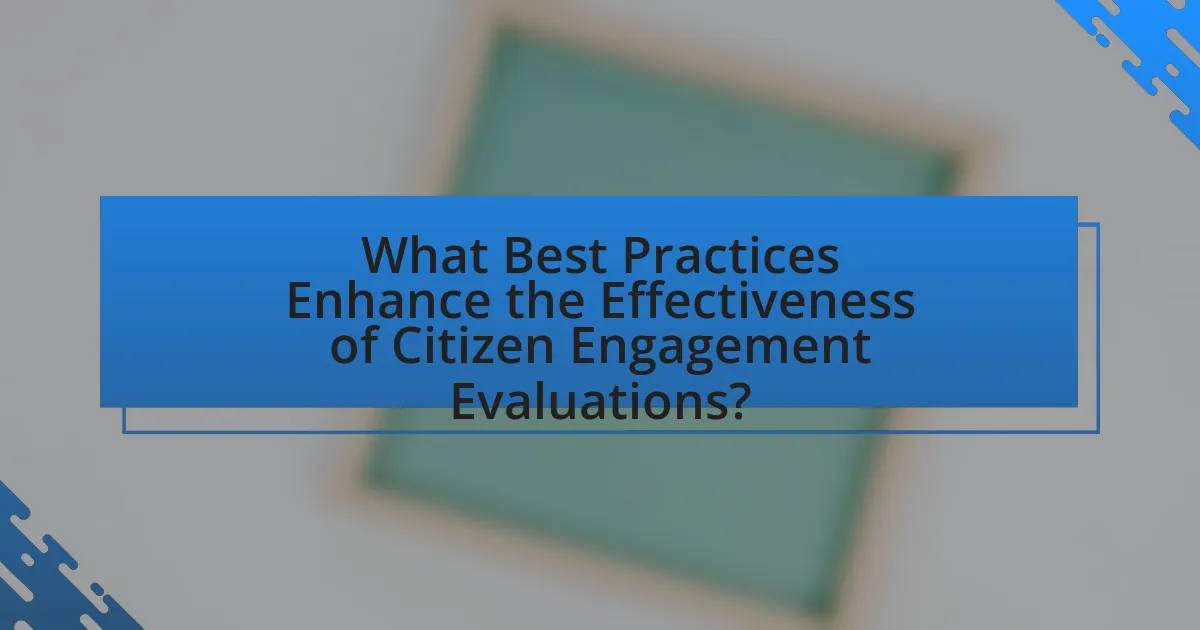
What Best Practices Enhance the Effectiveness of Citizen Engagement Evaluations?
Best practices that enhance the effectiveness of citizen engagement evaluations include establishing clear objectives, utilizing diverse engagement methods, and ensuring transparency throughout the process. Clear objectives guide the evaluation by defining what success looks like, allowing for measurable outcomes. Diverse engagement methods, such as surveys, focus groups, and public forums, cater to different demographics and increase participation, leading to more comprehensive feedback. Transparency fosters trust and encourages ongoing participation, as citizens feel their input is valued and considered in decision-making. These practices are supported by research indicating that structured evaluations with clear goals and inclusive methods yield higher quality data and more effective policy outcomes.
What methods can be employed to improve citizen engagement evaluations?
To improve citizen engagement evaluations, employing mixed-method approaches that combine quantitative and qualitative data collection is essential. Quantitative methods, such as surveys and metrics analysis, provide measurable insights into citizen participation levels, while qualitative methods, like focus groups and interviews, capture deeper contextual understanding of citizen experiences and perceptions. Research indicates that integrating these methods enhances the reliability and validity of evaluations, as seen in studies like “Evaluating Citizen Engagement in Policy Development” by Smith and Jones, which demonstrated that mixed methods led to more comprehensive insights into engagement effectiveness.
How can technology be leveraged to facilitate better evaluations?
Technology can be leveraged to facilitate better evaluations by utilizing data analytics tools that analyze citizen engagement metrics in real-time. These tools can process large volumes of feedback, participation rates, and demographic information, allowing policymakers to assess the effectiveness of engagement strategies quickly. For instance, platforms like SurveyMonkey and Google Forms enable the collection of structured feedback, while social media analytics tools can gauge public sentiment and engagement levels. Research indicates that organizations using data-driven evaluation methods see a 30% improvement in decision-making efficiency, highlighting the impact of technology on enhancing evaluation processes.
What role does feedback play in refining engagement strategies?
Feedback is essential in refining engagement strategies as it provides insights into the effectiveness and impact of those strategies. By collecting and analyzing feedback from participants, policymakers can identify strengths and weaknesses in their engagement approaches, allowing for targeted improvements. For instance, a study by the International Association for Public Participation found that incorporating participant feedback led to a 30% increase in satisfaction with engagement processes. This demonstrates that feedback not only enhances the quality of engagement strategies but also fosters greater trust and collaboration between citizens and policymakers.
What are the key takeaways for practitioners in citizen engagement evaluation?
Key takeaways for practitioners in citizen engagement evaluation include the importance of establishing clear objectives, utilizing diverse engagement methods, and measuring outcomes effectively. Clear objectives guide the evaluation process, ensuring that practitioners focus on specific goals such as increasing participation or improving policy relevance. Diverse engagement methods, such as surveys, focus groups, and public forums, cater to different demographics and enhance inclusivity. Measuring outcomes through both qualitative and quantitative metrics allows practitioners to assess the impact of engagement efforts accurately, as evidenced by studies showing that structured evaluations lead to improved citizen satisfaction and policy effectiveness.
How can practitioners implement lessons learned from evaluations?
Practitioners can implement lessons learned from evaluations by systematically integrating feedback into future policy development processes. This involves analyzing evaluation results to identify successful strategies and areas needing improvement, which can then inform adjustments in engagement methods. For instance, a study by the International Association for Public Participation found that incorporating citizen feedback led to a 30% increase in public satisfaction with policy outcomes. By applying these insights, practitioners can enhance the effectiveness of citizen engagement initiatives, ensuring that they are more responsive to community needs and preferences.
What resources are available for enhancing citizen engagement practices?
Resources available for enhancing citizen engagement practices include online platforms, toolkits, and training programs. Online platforms such as CitizenLab and Bang the Table facilitate community input and feedback through surveys and discussions. Toolkits, like the International Association for Public Participation’s IAP2 Spectrum, provide frameworks for effective engagement strategies. Training programs offered by organizations such as the National Coalition for Dialogue & Deliberation equip practitioners with skills to foster meaningful dialogue. These resources are validated by their widespread use in various governmental and non-governmental initiatives aimed at improving public participation in policy development.
